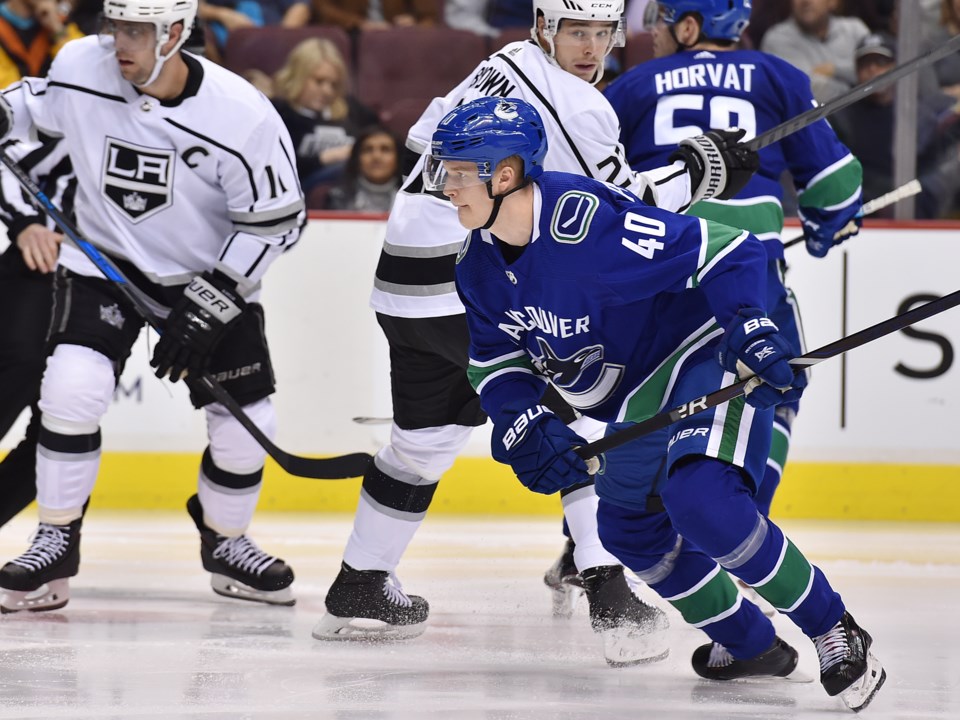Elias Pettersson is so good that even when he’s injured, he can still make news.
It’s been clear to Canucks fans all season just how important Pettersson is to the team, but it was driven home by their performance without him in the lineup over the last couple games. Pettersson has the ability to almost single-handedly win a game, such as his hat trick against the Ottawa Senators.
How many wins, exactly, is Elias Pettersson worth? If you were to replace Pettersson with someone else — say, a player plucked off waivers — what would be the impact on the Canucks?
That’s the question that WAR is designed to answer, more or less. WAR, which stands for Wins Above Replacement, is a well-accepted concept in baseball, to the point that it has a significant influence on end-of-year awards voting and “best player” conversations. It’s had a tougher time getting accepted in hockey for a number of reasons, but there’s one good reason why Canucks fans, even those who are averse to any sort of advanced statistics, might be won over.
Elias Pettersson leads the NHL in WAR.
At least, one version of WAR. It’s complicated.
The purpose of WAR is to try to capture the value of a player in one number. It measures this value in wins provided over a replacement-level player, ie. a player that could be readily acquired via waivers or a call-up from the AHL. In general, WAR is more descriptive than predictive: it describes how valuable a player has been, but does not necessarily predict how valuable that player will be in the future.
The issue is that there are multiple ways to measure a player’s value and multiple ways to combine those measurements into one number. As a result, there isn’t just one WAR metric.
The creators of the now-defunct WAR-on-ice created their version of WAR before they were all hired by NHL teams, as did Dawson Sprigings, a former NCAA Division 3 goaltender turned analyst, who then got hired by Kroenke Sports Entertainment, who own the Colorado Avalanche, Denver Nuggets, Arsenal, and multiple other professional teams.
The current versions of WAR that are publically available come from Emmanuel Perry, who runs Corsica.hockey, and Josh and Luke Younggren, the twins behind Evolving Hockey.
According to both versions of WAR, Pettersson has been very, very valuable to the Canucks this season. They just disagree on the exact value.
Perry’s model rates Pettersson as the most valuable player in the NHL, providing 4.06 wins above a replacement-level player. That’s in spite of the games he’s missed due to injury.
That may not seem like much, but think of it over the course of a full-82 game season. Over 82 games, Pettersson provides 8.75 wins. Look at the Colorado Avalanche last season, who snuck into the playoffs in the second wild card spot with a 43-30-9 record. Take away nine wins and they plunge to 12th in the Western Conference and end up drafting in the top 10.
To put it another way, nine wins last season was the difference between being the St. Louis Blues and missing the playoffs and being the Nashville Predators and winning the Presidents’ Trophy.
Here are the top 20 WAR ratings according to Perry’s model:
You might take issue with Perry’s model based on the players that appear on this list and where they rank, but keep this in mind: Pettersson is the best player in the NHL by this model. How much do you really want to argue against that conclusion?
The Younggrens’ model is in mild disagreement with Perry’s, ranking Pettersson as the fourth-best player in the NHL, behind John Carlson, Sidney Crosby, and Brayden Point. What I find most interesting is how much lower the numbers are for the Evolving Hockey WAR in comparison to Corsica’s WAR.
According to Evolving Hockey, Pettersson is worth 2.5 wins compared to a replacement-level player. Since the Younggrens start with Goals Above Replacement (GAR), I’ve included that number as well, and Pettersson is worth 14.4 goals compared to a replacement-level player according to that metric.
Why is there such a large difference between the two numbers? There are likely a number of factors, but one may be the different ways they measure a replacement-level player.
From Perry’s comprehensive write-up of his WAR model (which includes the exact code he uses in R), he defines a replacement-level player as one earning a league-minimum salary. The Younggrens, on the other hand, define replacement level using the skaters outside the top 13 forwards and 7 defencemen on each team.
Perhaps these two methods of defining a “replacement-level player” come up with a very different baseline with which to compare the rest of the NHL.
There are areas in which the two models agree, such as the key areas where Pettersson provides value. Corsica highlights his shooting ability, with 3.22 of his 4.06 WAR coming from his shooting. Likewise, the bulk of Pettersson’s WAR according to Evolving Hockey comes from his even-strength offence, which loops in his shooting ability. The other major contributor in both models is his ability to draw penalties, which ranks among the elite in that area, like Aleksander Barkov, Nico Hischier, and Nathan Mackinnon.
The next most valuable players on the Canucks also differ depending on which WAR model you’re looking at. Corsica’s WAR rates Jacob Markstrom second on the Canucks, with 0.80 WAR compared to Pettersson’s 4.06, then Brock Boeser (0.77), Josh Leivo (0.50, including his time in Toronto), and Bo Horvat (0.23).
Evolving Hockey’s WAR has Troy Stecher as second most valuable at 1.0 to Pettersson’s 2.5, followed by Alex Edler (0.9), Brock Boeser (0.9), Antoine Roussel (0.7), Josh Leivo (0.5), Chris Tanev (0.4), Bo Horvat (0.3), and Nikolay Goldobin (0.3).
The stark difference between Pettersson and the rest of the Canucks is a stark illustration of just how valuable Pettersson is to the team.



